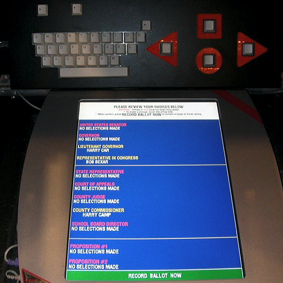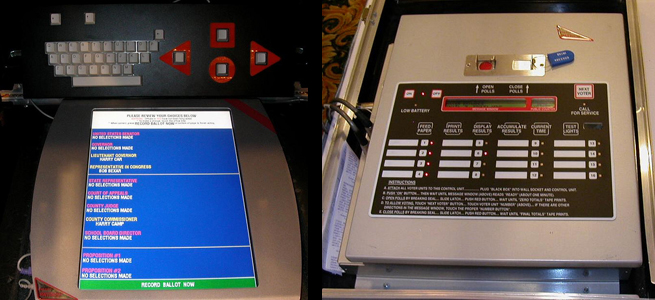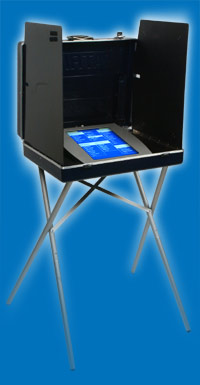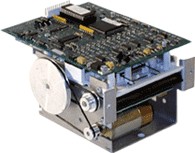
Unilect Corporation
Patriot (and Patriot Marksense Scanner)
Make / Model: UniLect Patriot (and Patriot Marksense Scanner)
Equipment Type: Direct Recording Electronic (DRE)
Summary



The UniLect Patriot is a multilingual electronic voting system on which the voter presses on-screen to indicate their preference. Election officials program ballot information at a central location, load election data into an “InfoPack” which is then inserted into a Precinct Control Unit. Individual terminals are connected together into the PCU to receive ballot data. Patriot voting devices, include a standard punch card type voting booth that folds up into an attached case. The Voter Unit may contain either a 10.4″ (diagonal measurement) black and white screen or a 15″ color screen with 256 available colors. One precinct control unit (PCU) per precinct (30 lbs.), has an election worker control panel covering all aspects of running the activities in the precinct, a printer which allows the printing of precinct results as soon as the polls close, a battery to assure proper operation when “wall” electricity becomes unavailable, an InfoPack which contains the brains of the ballot as well as final vote totals, and an internal modem for direct transfer of totals from a standard telephone in the precinct to the Patriot Central Station, in the election office.
Voters make selections by pressing the box surrounding a candidate’s name, navigating through ballot pages by means of navigation buttons, review their ballots by means of a summary screen, and can go back and change selections before casting their final votes. Vote data is stored in redundant memory inside each terminal. After polls close, vote data is loaded back into the PCU and can then be transmitted via modem to a tabulation center. Alternatively, the InfoPack” (which store the vote data from all of the terminals at the polling place) can be removed from the PCU and taken to a tabulation center.
Ballot information is generally programmed by city or county election officials and later delivered to polling places. In order to create the ballots that will be used on the Patriot terminals, a menu-driven program is used to prompt the entry of all offices, candidates and propositions in order to “code” the election. Election officials have the option to print out the ballot on paper for proofreading purposes. Ballot data is transferred to polling places in the form of an administrator interface loaded with precinct-specific data. By placing an “InfoPack” (a little larger than a pack of cigarettes) into the “InfoPacket” attached to the PC, the necessary ballot instructions are electronically transferred from the election supervisor PC to the InfoPack (about 5 seconds). It is then inserted into the Precinct Control Unit (“PCU” – see above photo) for the appropriate precinct. It is tested, sealed and sent to the precinct along with the prescribed number of Patriot Voting Devices.
In order to load the proper ballots into the Patriot terminals, the precinct workers place the PCU on the table and set up each booth. These are then connected from one to another by a cord similar in size to a lamp cord. The PCU is then turned on. With the PCU in front of them, one of the precinct workers breaks the seal on the “Open Polls” latch, slides it open, and touches the red button underneath. This immediately causes the printer to print a report showing all the candidates with zero totals.
Most jurisdictions using the UniLect Patriot for polling place voting emply Unilect software for tabulating absentee ballots. Unilect software is used in configuration with the VMR 138, a commercial off-the-shelf (COTS) high speed printer made by Peripheral Dynamics. The Unilect Patriot has also been submitted for state certification in configuration with two other scanners, described as Model 1000 (high speed) and Model 20 (single feed).
As of 2018, the UniLect Patriot is no longer used in U.S. elections.
Voting Process
After checking in at the polling place, a poll worker assigns the voter to a specific Patriot voting terminal. Where available, the voter selects his or her preferred language by pressing the appropriate on-screen button. The voter makes each candidate selection by touching anywhere in the box containing that name. As each is selected, a red “x” appears next to the candidate’s name. The voter may navigate forward or back through ballot screens by touching the appropriate navigation boxes at the top of the screen. If a mistake is made, the selected candidate’s box may be touched again (de-selecting him or her), and the new candidate selected. Write-ins may be electronically entered by touching the “Write-In” box for a particular office. Immediately the screen changes to display an alphabet, and the write-in name may be spelled by touching the proper letters.
When finished voting, the voter presses the “Review Choices” on-screen button. The summary screen will display the voter’s selections made to this point and will highlight those offices which were not completed by the voter. At that point, the voter may press the “Make Ballot Changes” button to return to the ballot or “Record Ballot Now” button to cast his or her ballot. After the “Record Ballot Now” button is pressed, a green screen appears informing the voter that his or her ballot has been cast.
Unilect offers several accessibility features associated with the Patriot, although it is unclear if these features are readily available and installed on each terminal. These include the ability to disconnect and move terminals to enable “curb-side” voting, headphones and different shaped response buttons to facilitate voting by the sight-impaired, etc.
Post-election Procedures: At the end of the election day, a seal is broken on the “Close Polls” latch, opened and an exposed red button is touched. Several copies of the final precinct report are automatically printed, showing the candidates and their vote totals. Presumably, vote data is at this stage transferred back from the terminals to the PCU. Where a standard telephone line is available, the line is inserted into the phone jack of the Precinct Control Unit. All precinct totals are then transmitted directly to the Central Office PC. It is unclear whether this process is automated or whether poll workers must take affirmative action to initiate this upload. Another seal is then broken and the InfoPack is removed in order to be taken to a tabulation center.
At the tabulation center, each InfoPack (for precinct totals not sent by telephone) is inserted into a central PC equipped with the Patriot InfoPacket for a five (5) seconds to load the totals into the PC. Throughout election evening, summary reports can be printed showing all of the up-to-the-minute totals as they are received (including all write-ins).
Carteret County North Carolina 2004
UniLect Patriot DREs were used in Carteret County, North Carolina for early voting in the 2004 election. Because the machine had a storage capacity of only 3005 ballots and the number of early voters far exceeded the machine’s capacity, 4438 ballots were lost. Only 2287 votes separated the Republican and Democratic candidates for state Agricultural Commissioner, and a rerun of the Agricultural Commissioner election seemed an obvious solution. The State Board of Elections’ decision to hold a revote in Carteret County only was struck down by the court. The Board of Elections then called for a statewide revote. That, too, was struck down, and the bitterly divided Board was ordered to resolve the election some other way. Eventually, 1352 affidavits were collected by the leading candidate from voters claiming to have voted for him. Since there were enough affidavits to guarantee the election of the leading candidate, and since the judge appeared ready to accept the affidavits, the other candidate conceded. This may be the first time that an election in the United States was decided by affidavits. The UniLect Patriot was decertified in Pennsylvania in 2005 and is now used only in Virginia.
Voting Instructions
1. After checking in, go to the voting booth. Your ballot should be already available on-screen, touch anywhere to begin.
2. Select candidates by touching their names or the adjacent box, touch again to deselect. To vote for a write-in candidate, touch the Write-In line – a keyboard will appear. Type in the name of the candidate, touch the Record Write-In button to continue.
3. Touch the Review Choices button at the top of the screen after you finish making your selections to go to the summary screen. There, review you choices and, when satisfied, touch the Record Ballot Now button.
Security Concerns
Security
The very design of Patriot makes it inherently much more secure than many competitive products. By not networking the Voter Units, using no operating system on the PCU and attaching no keyboard to either, the opportunities for malicious attack are significantly reduced. This does not mean that the system is invulnerable, however. At the Central Station, a capability for “manual edit” of vote totals is provided. This means nothing less than the ability change vote totals to any desired numbers. It is true that any totals must conform to the canvass, but this is commonly not understood by the public and is not understood at all by the legion of computer scientists who have criticized DRE voting as inherently unsafe. Nevertheless, the public perception that an insider can alter vote totals, even if those totals are not used to declare an official winner, makes it imperative that it be prevented.
The vendor pointed out that any effort to change totals would be logged in a log file, so we explored that path during the examination. The “log,” both on the PCU and the Central Station, consists of a file of information. On the Central Station, this is an unencrypted text file that is editable by the user. It is possible, therefore, for someone to alter the vote totals and then edit the log to remove any mention of the change. Furthermore, the log only records events that are initiated through the Patriot software. Functions performed through the Windows operating system interface, such as copying, deleting or substituting a file, are not logged at all. So another way of altering vote totals is to replace the totals file by another, and this will also not be logged.
The precinct log, maintained at the PCU, is rudimentary. It does not record each event of voting, but only gross milestones such as the opening and closing of polls. It is not possible to tell from the log, for example, how many voters voted. It also contains no record of provisional voting at all. A solution to the problem of log file editing is to keep the log on a write-once device, such as a CD-R or a paper printer. In an implementation provided by UniLect in Texas, a paper log printer must be connected to the Central Station and no functions can be performed if the printer is not in “ready” condition. In this way it is not feasible to alter log records, although certain events can transpire that would still not be logged.
Reliability
Among the complaints received about the Patriot system is that the touchscreen does not function reliably. That is, when a voter touches the screen, the touch is not necessarily sensed, which results in the voter incorrectly believing that she has cast a vote. This behavior was observed during the examination, when sometimes multiple depressions did not result in the touch being sensed. The vendor explained that the screen is made up of a large number of individual “pouches” and that it is necessary to press a pouch in order for the vote to be detected. At times, the voter may touch the screen between two pouches, which has no effect.
While it is satisfying to some degree to understand why the screen does not always function, such an explanation would be of little solace to a voter whose choice was ignored as a result. The screen is supposed to have 44 voting positions that can be sensed. These are not marked on the screen and the vendor stated that there is no effective procedure for testing whether all 44 positions are working.
A different but possibly related problem is that the system occasionally enters a mode in which no touch at all can be recorded anywhere on the screen. This behavior can be observed in the Pennsylvania re-examination in 2005. The screen froze up and would not respond to any input. While the vendor did not respond to entreaties to explain what he was doing or what the nature of the problem might be, his solution was to disconnect the non-functioning unit. I was not able to determine whether the condition was caused by a malfunction of the screen hardware or whether it was a software problem. Nevertheless, it was consistent with reports that have been received concerning DRE screen failures.
References
UniLect Patriot Evaluation, Michael Shamos for Pennsylania Secretary of the Commonwealth (2005)
First Re-examination of the UniLect Patriot, Pennsylvania Secretary of the Commonwealth (April 2005)
Second Re-examination of the UniLect Patriot, Pennsylvania Secretary of the Commonwealth (May 2005)
Manufacturer Profile

UniLect Corporation
P.O. Box 3026
Danville, CA 94526-8026
925-833-8660, 888-UNILECT toll-free
925-833-8874 fax
info@unilect.com
http://unilect.com